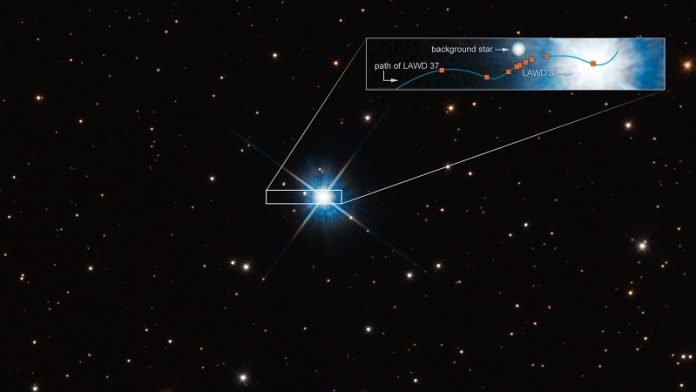
Astronomers have directly measured the mass of a dead star using an effect known as gravitational microlensing, first predicted by Einstein in his General Theory of Relativity, and first observed by two Cambridge astronomers 100 years ago.
The international team, led by the University of Cambridge, used data from two telescopes to measure how light from a distant star bent around a white dwarf known as LAWD 37, causing the distant star to temporarily change its apparent position in the sky.
This is the first time this effect has been detected for a single, isolated star other than our Sun, and the first time the mass of such a star has been directly measured.
The results were reported in the Monthly Notices of the Royal Astronomical Society.
LAWD 37 is a white dwarf, the result of the death of a star like our own.
When a star dies, it stops burning its fuel and expels its outer material, leaving only a hot, dense core.
Under these conditions, matter as we know it behaves very differently and turns into something called electron-degenerate matter.
“White dwarfs give us clues into how stars evolve – someday our own star will end up as a white dwarf,” said lead author Dr Peter McGill, who carried out the research while completing his PhD at Cambridge’s Institute of Astronomy. McGill is now based at the University of California, Santa Cruz.
LAWD 37 has been extensively studied, as it is relatively close to us. This white dwarf is 15 light-years away in the Musca constellation and is what remains of a star that died around 1.15 billion years ago.
“Because this white dwarf is relatively close to us, we’ve got lots of data on it – we’ve got information about its spectrum of light, but the missing piece of the puzzle has been a measurement of its mass,” said McGill.
Mass is one of the most important factors in a star’s evolution. For most stellar objects, astronomers infer mass indirectly, relying on strong, often untested modelling assumptions.
In rare cases where mass can be directly inferred, the object has to have a companion, such as a binary star system. But for single objects, such as LAWD 37, other methods for determining mass are needed.
McGill and his international team of colleagues were able to use a pair of telescopes – the European Space Agency’s Gaia Telescope and The Hubble Space Telescope – to get the first accurate mass measurement for LAWD 37 by predicting, and then observing, an astrometric effect first predicted by Einstein.
In his General Theory of Relativity, Einstein predicted that when a massive compact object passes in front of a distant star, the light from the star would bend around the foreground object due to its gravitational field. This effect is known as gravitational microlensing.
In 1919, two British astronomers – Arthur Eddington from Cambridge and Frank Dyson from the Royal Greenwich Observatory – first detected this effect during a solar eclipse, in what was the first popular confirmation of General Relativity. However, Einstein was pessimistic that the effect would ever be detected for stars outside our solar system.
In 2017, astronomers detected this gravitational microlensing effect for another nearby white dwarf in a binary system, Stein 2051 b, which marked the first detection of this effect for a star other than our Sun. Now, the Cambridge-led team has detected the effect for LAWD 37, giving the first direct mass measurement for a single white dwarf.
Using ESA’s Gaia satellite, which is creating the most accurate and complete multi-dimensional map of the Milky Way, the astronomers were able to predict the movement of LAWD 37 and identify the point where it would align close enough to a background star to detect the lensing signal.
Using the Gaia data, the astronomers were able to point The Hubble Space Telescope in the right place at the right time to observe this phenomenon, which happened in November 2019, 100 years after the famous Eddington/Dyson experiment.
Since the light from the background star was so faint, the main challenge for astronomers was extracting the lensing signal from the noise.
“These events are rare, and the effects are tiny,” said McGill. “For instance, the size of our measured effect is like measuring the length of a car on the Moon as seen from Earth, and is 625 times smaller than the effect measured at the 1919 solar eclipse.”
Once they had extracted the lensing signal, the researchers were able to measure the size of the astrometric deflection of the background source, which scales with the mass of the white dwarf, and obtain a gravitational mass for LAWD 37 that is 56 percent the mass of our Sun.
This agrees with earlier theoretical predictions of LAWD 37’s mass, and corroborates current theories of how white dwarfs evolve.
“The precision of LAWD 37’s mass measurement allows us to test the mass-radius relationship for white dwarfs,” said McGill. “This means testing the properties of matter under the extreme conditions inside this dead star.”
The researchers say their results open the door for future event predictions with Gaia data that can be detected with space-based observatories such as JWST, the successor to Hubble.
“Gaia has really changed the game – it’s exciting to be able to use Gaia data to predict when events will happen, and then observe them happening,” said McGill. “We want to continue measuring the gravitational microlensing effect and obtain mass measurements for many more types of stars.”
The research was supported in part by NASA, the Science and Technology Facilities Council (STFC), part of UK Research & Innovation (UKRI), and the European Space Agency.
Written by Sarah Collins.



